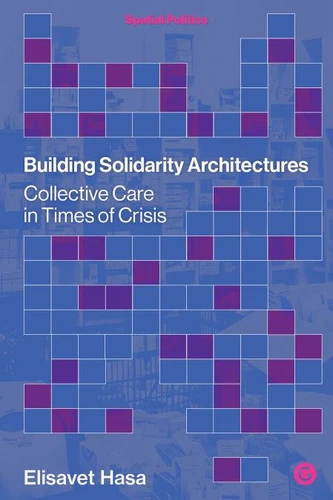Building Solidarity Architectures. Collective Care in Times of Crisis
Par :Formats :
Actuellement indisponible
Cet article est actuellement indisponible, il ne peut pas être commandé sur notre site pour le moment. Nous vous invitons à vous inscrire à l'alerte disponibilité, vous recevrez un e-mail dès que cet ouvrage sera à nouveau disponible.
Disponible dans votre compte client Decitre ou Furet du Nord dès validation de votre commande. Le format ePub protégé est :
- Compatible avec une lecture sur My Vivlio (smartphone, tablette, ordinateur)
- Compatible avec une lecture sur liseuses Vivlio
- Pour les liseuses autres que Vivlio, vous devez utiliser le logiciel Adobe Digital Edition. Non compatible avec la lecture sur les liseuses Kindle, Remarkable et Sony
- Non compatible avec un achat hors France métropolitaine
 , qui est-ce ?
, qui est-ce ?Notre partenaire de plateforme de lecture numérique où vous retrouverez l'ensemble de vos ebooks gratuitement
Pour en savoir plus sur nos ebooks, consultez notre aide en ligne ici
- Nombre de pages248
- FormatePub
- ISBN978-1-915983-15-2
- EAN9781915983152
- Date de parution06/01/2026
- Protection num.Adobe DRM
- Infos supplémentairesepub
- ÉditeurGoldsmiths Press
Résumé
On the spatial politics underlying the strategies of state abandonment in cities today. Based on the foreground of a prolonged financial crisis, global pandemic, structural and racial violence, Building Solidarity Architectures examines how solidarity and decolonial movements are creating spaces of collective care, stepping in as providers of welfare services, and, in multiple contexts, acting as the first responders in support of disenfranchised communities.
By defining state abandonment as a constantly resurging logic of withdrawing welfare services and deterioration of welfare infrastructures that predominantly affect the most marginalized groups, the book offers readers a lens to recognise forms of state abandonment in various localities and the potential collective responses to them. The book also delves into the materiality that results from this contestation and is therefore embedded in primary sources such as participant testimonies, activist texts, visuals, and images, to provide a rich and engaging account of what one could call a "lived architecture" of everyday practical, immediate, and coping mechanisms of collective care.
It ultimately investigates how mutual aid and solidarity can also function as a material resource that counteracts the materiality of abandonment resurfacing in times of crisis. By exploring solidarity as a way of life, Building Solidarity Architectures helps us envision new places of liberation, reorganise the ways we live together, and reproduce the tools we have created for change to happen.
By defining state abandonment as a constantly resurging logic of withdrawing welfare services and deterioration of welfare infrastructures that predominantly affect the most marginalized groups, the book offers readers a lens to recognise forms of state abandonment in various localities and the potential collective responses to them. The book also delves into the materiality that results from this contestation and is therefore embedded in primary sources such as participant testimonies, activist texts, visuals, and images, to provide a rich and engaging account of what one could call a "lived architecture" of everyday practical, immediate, and coping mechanisms of collective care.
It ultimately investigates how mutual aid and solidarity can also function as a material resource that counteracts the materiality of abandonment resurfacing in times of crisis. By exploring solidarity as a way of life, Building Solidarity Architectures helps us envision new places of liberation, reorganise the ways we live together, and reproduce the tools we have created for change to happen.
On the spatial politics underlying the strategies of state abandonment in cities today. Based on the foreground of a prolonged financial crisis, global pandemic, structural and racial violence, Building Solidarity Architectures examines how solidarity and decolonial movements are creating spaces of collective care, stepping in as providers of welfare services, and, in multiple contexts, acting as the first responders in support of disenfranchised communities.
By defining state abandonment as a constantly resurging logic of withdrawing welfare services and deterioration of welfare infrastructures that predominantly affect the most marginalized groups, the book offers readers a lens to recognise forms of state abandonment in various localities and the potential collective responses to them. The book also delves into the materiality that results from this contestation and is therefore embedded in primary sources such as participant testimonies, activist texts, visuals, and images, to provide a rich and engaging account of what one could call a "lived architecture" of everyday practical, immediate, and coping mechanisms of collective care.
It ultimately investigates how mutual aid and solidarity can also function as a material resource that counteracts the materiality of abandonment resurfacing in times of crisis. By exploring solidarity as a way of life, Building Solidarity Architectures helps us envision new places of liberation, reorganise the ways we live together, and reproduce the tools we have created for change to happen.
By defining state abandonment as a constantly resurging logic of withdrawing welfare services and deterioration of welfare infrastructures that predominantly affect the most marginalized groups, the book offers readers a lens to recognise forms of state abandonment in various localities and the potential collective responses to them. The book also delves into the materiality that results from this contestation and is therefore embedded in primary sources such as participant testimonies, activist texts, visuals, and images, to provide a rich and engaging account of what one could call a "lived architecture" of everyday practical, immediate, and coping mechanisms of collective care.
It ultimately investigates how mutual aid and solidarity can also function as a material resource that counteracts the materiality of abandonment resurfacing in times of crisis. By exploring solidarity as a way of life, Building Solidarity Architectures helps us envision new places of liberation, reorganise the ways we live together, and reproduce the tools we have created for change to happen.



